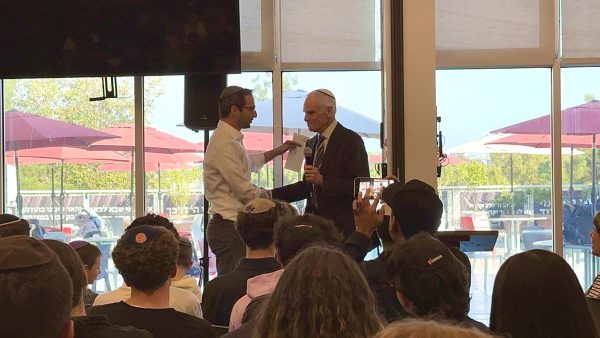New fellowship at LA Holocaust Museum lets seniors see history through the eyes of victims

(www.shalhevetlamothfellows.weebly.com) LEARNING: Seniors Liat Bainvoll, Liat Menna and Sharona Sedighim hear from Dr. Rachel Korazim, a Holocaust education specialist, as part of the new Shalhevet-LAMOTH fellowship. The girls visit the museum three times a week to learn about the Holocaust.
March 17, 2014
By Nicole Soussana, Staff Writer,
and Tamar Willis, Editor-in-Chief
Three seniors have become the first-ever Madrichim Fellows of the Los Angeles Museum of the Holocaust, and are spending three class periods a week this semester meeting with survivors and studying and researching artifacts at the museum in Pan Pacific Park.
According to Liat Bainvoll, the fellowship’s approach to Holocaust education is to focus on individuals rather than the overall history and time.
“Case studies and specific artifacts… form emotional ties and connections with the Holocaust, more than just facts and numbers and ideas [can],” Liat said. “There are just small snippets of one person’s story that give you emotions you can’t put into words.”
After learning about the Holocaust on a macro level, each girl chose an artifact or audio recording in the museum’s collection which they will be researching until the end of the fellowship. For example, the girls have learned about poetry that was written during the times of the Holocaust and how it intertwines with stories from Tanach.
Usually, the girls leave campus during lunch and sometimes during one of their mini-mester periods. But some weeks they have visited the museum only twice, staying at school for the third session and reflecting on their experiences together.
At the museum, the girls spend their time meeting survivors and experts and researching their artifacts. Last month, they met with Dr. Rachel Korazin, a specialist in Holocaust education, to talk about poetry written by Holocaust victims.
As part of the project, the girls also have created a blog, www.shalhevetlamothfellows.weebly.com, where they share their findings and experiences.
Liat Menna’s Feb. 18 post was about the impact a survivor named Sol Berger had on her views of the Holocaust. Hearing Sol’s story reinforced Liat’s desire to commemorate the survivors and prevent any future Holocausts.
“I am here as one of the voices that will keep the real story of the Holocaust and its legacy alive,” wrote Liat, “preserving the memories of all who perished or survived the Holocaust and making sure nothing of that sort happens again.”
That’s exactly the goal of the fellowship, said Mrs. Ruthie Skaist, Shalhevet’s Chesed advisor, who oversees the fellows.
“In order to keep history alive, it just makes sense to give it over to high school students,” said Mrs. Skaist, “who can then give it on to their peers and future high school students, as opposed to just adults giving it over to more adults. It’s a lot more powerful when it’s done like this.”
Museums can feel somewhat antiquated to students, she added.
“High school students are young and vibrant and passionate and excited,” she said, “so if we’re able to connect the two, we can make it a community center as opposed to just a place that’s there to hold onto memories.”
Samara Hutman, LAMOTH’s Executive Director, said that she had been wanting to create a program like this for a while, and that it’s much more than just a volunteer or educational program for the teens that participate.
“The deepest part of the work is looking to inspire and to make a place for young people who have a passion for the future of Jewish memory and they can begin very young to take their place in that work,” said Ms. Hutman. “So I see them less as volunteers and more as young people preparing themselves to step up to their own leadership roles in the Jewish community many years ahead.”
Additionally, Shalhevet has been paired with a brother school in Jerusalem, the Hartman High School for boys, who are part of a similar internship at the Beit Terezin Holocaust museum there.
Both museums were founded by Holocaust survivors themselves and built by the community, and the girls are planning to meet with the boys in Israel during the seniors’ Poland-Israel trip to share their experiences.
“Before, all I knew about the Holocaust were some words on paper,” Sharona said. “Going to the museum has allowed me to gain a a more personal experience with the survivors and the Holocaust.”












